Pediatric
The American Association of Orthodontists
recommends that all children, regardless of
their orthodontic progression, receive an
orthodontic evaluation by age seven. Early
examination allows orthodontists to determine
the best time for orthodontic treatment, and if
necessary, to begin.
Early interceptive orthodontic therapy can
minimize the need for more complex treatment in
the future.
Adolescent
By the time children reach adolescence, their
permanent teeth are either in, or are erupting.
Teenagers jaw bones are almost finished growing,
making this an ideal time to correct their
teeth.
People whose teeth are crooked or misaligned
are often self conscious about their appearance.
By starting early, you can give your child a
healthy smile with a lifetime of benefits.
Seeing our patients grow and mature into
confident young adults is one of our greatest
rewards.
Adult
No matter what your age, appearance is an
important aspect of your life. You are never too
old for orthodontic treatment. In fact, thirty
percent of our patients are adults.
Many adults seek orthodontic treatment not
just for the sake of their smiles, but to
improve the function of their bite.
Adult orthodontics are more convenient and
comfortable than ever. Technological
advancements have made adulthood a great time to
achieve the smile you have always wanted.
Types of Braces/Brackets
There are a variety of options in styles of
braces or brackets, from the raditional metal
brackets to a less visible type. Check out the
choices and discuss the options at your first
visit.
Traditional Metal Braces
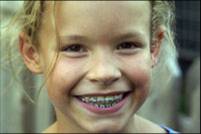 Traditional braces or brackets are the most
common type and are made of high-grade stainless
steel. For patients involved in contact sports
and for durability, metal braces are a must.
They are much different than the large, bulky
appliances of past years. Today’s metal braces
are much smaller, more comfortable and less
noticeable. You also have the option of adding
color to your braces at each visit - a fun way
to brighten your smile. Traditional braces or brackets are the most
common type and are made of high-grade stainless
steel. For patients involved in contact sports
and for durability, metal braces are a must.
They are much different than the large, bulky
appliances of past years. Today’s metal braces
are much smaller, more comfortable and less
noticeable. You also have the option of adding
color to your braces at each visit - a fun way
to brighten your smile.
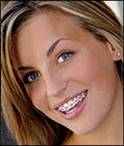 Self-ligating Braces Self-ligating Braces
Dr. Garemani offers the most technically
advanced style of “silver” braces today. The
newest type is the Damon System. This system
uses a slide mechanism, not the conventional
elastics, to hold the arch wire in place. This
eliminates much of the friction and binding
active tooth movement. The brackets provide not
only exceptional aesthetics, but quicker
treatment time as well!
Clear Braces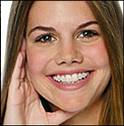
Unlike
ceramic braces that are opaque, the clear
brackets we offer are crystal clear and
virtually disappear onto the tooth. The “ice”
brackets won’t stain or discolor and are
completely transparent. The clear braces are a
popular choice for our adult patients and some
teens.
Invisalign ®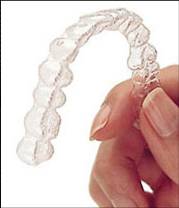
Dr. Garemani is a Certified Invisalign®
Provider. New advances in orthodontics make it
possible to have braces that are practically
invisible. Invisalign® is a state-of-the-art
alternative to traditional braces that is
virtually undetectable to other people.
Invisalign straightens your teeth without
brackets or wires, just a series of customized
removable appliances called “aligners.” If you
are considering this option for your orthodontic
treatment, Dr. Garemani will be able to
determine if Invisalign is right for you.
Back to the Top
Crossbites occur when the palate and upper
jaw constrict so one or more upper and lower
teeth don’t match on one or both sides.
Crossbites also occur when teeth are reversed in
position. Early correction of a crossbite is
highly recommended because it can cause:
- Excessive wear of the teeth
- Gum disease, including loss of bone
surrounding the tooth
- Jaw deformity
- Improper chewing patterns
- An unattractive smile
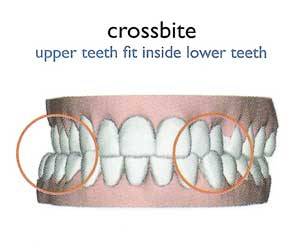
Crossbites can be corrected with Braces or
other Orthodontic appliances.
An underbite is when the lower front teeth
bite over the upper front teeth. This is the
opposite of how a normal bite is supposed to be
arranged. It could be named a reverse bite and
is sometimes cruelly called a bull dog bite.
It's opposite of an overbite and is often
referred to as a Class III malocclusion.
In almost all cases, an underbite is caused
by nasal obstruction, mouth breathing and a
tongue thrust. The tongue has to stay down so it
doesn't block air from getting in. Many tongue
thrust patients brace their tongues against the
sides of their lower jaws and lower teeth when
they swallow. This constant pressure causes the
lower jaw to overgrow and creates a mismatch
between the larger lower jaw and smaller upper
jaw. The result is that only the back teeth
touch.
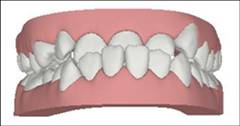
In most cases traditional metal braces are
needed, but orthodontists are now beginning to
use metal braces on the lowers and lingual
braces on top. Invisalign treatment for an
underbite is usually not effective, because
effective treatment may require rubber bands,
power chains, and other appliances to get as
much movement as possible.
An overbite occurs when the upper and lower
jaw don’t align properly, causing the placement
of the bottom teeth to sit unnaturally beneath
the top teeth. This can result in:
- head and jaw pain
- migraine headaches
- bone damage and other painful symptoms
Overbite correction is one of the most common
forms of orthodontic treatment. With a
malocclusion such as this, called a Class II
bite, the lower jaw does not reach out as far as
the top of the mouth. This can occur naturally,
through the wonder and curse of genetics, or
through bad habits like thumb sucking. The
longer a trait like this is left without
treatment, the worse the orthodontic problem can
become and the more intensive the treatment
required.
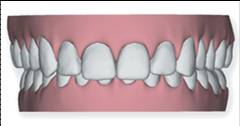
The orthodontic treatment for proper overbite
correction generally requires braces. If
overbite treatment begins at an early enough
age, with the use of an orthodontic appliance,
the use of braces can be minimized or even in
some cases avoided. It is generally possible to
tell what future orthodontic problems lie ahead
for a child by age 7. At this age it is a good
idea to get treatment to prevent further
problems.
 A
term used to describe forward tipping of the
incisor teeth. In children, this generally
occurs in response to thumb sucking or other
oral habits. In adults, it may occur following
the loss of several posterior (back) teeth,
which produces excess tipping force on the
anterior (front) teeth—especially the four
incisors. Periodontal disease may accelerate
incisor protrusion in adults, but is not
generally a problem for children. A
term used to describe forward tipping of the
incisor teeth. In children, this generally
occurs in response to thumb sucking or other
oral habits. In adults, it may occur following
the loss of several posterior (back) teeth,
which produces excess tipping force on the
anterior (front) teeth—especially the four
incisors. Periodontal disease may accelerate
incisor protrusion in adults, but is not
generally a problem for children.
The treatment is fairly straightforward and
can be started at any time. Essentially it
consists of using orthodontic braces to correct
the alignment of the teeth.
While a number of systems of braces exist,
they all involve a combination of wires,
brackets and bands which slowly force the teeth
to move to their correct location.
Modern orthodontics has made great advances
in tooth and jaw restoration and can totally
transform a person's looks as well as their
function. The results are often a complete
metamorphosis of the face.
The practical fact of the matter is that
nearly every one grinds their teeth at some time
or the other during their life. What matters is
the degree of the grinding. If the teeth
grinding is severe then it can result in:
- sleep disorders
- loosening of the teeth
- fracture
- excessive wear
With heavy grinding, the teeth tend to wear
out faster. In fact, the edges where upper and
lower teeth meet may become quite raw and
tender. Teeth will also tend to have an evenly
aligned appearance because they have been filed
down to a straight line. This wearing out can
result in the nerve endings becoming exposed,
which can then cause the teeth to develop
sensitivity to hot or cold. A patient will also
find small fractures on the teeth and small
pieces chipping off. The condition of your bite
also has much to do with grinding. In general,
if your bite is comfortable and relaxed, the
tendency for teeth grinding is significantly
reduced. Another indicator is the headache many
people have upon waking up. This is caused by
the unnatural tension in the muscles of the jaw.
Patients often undergo bite therapy to correct
this disorder.
 |
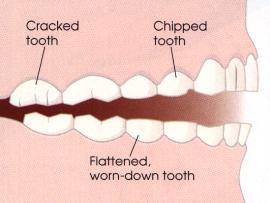 |
A simple TMJ appliance to reduce the effect
of heavy grinding is a mouth guard (also known
as a nightguard). This is an acrylic device that
fits snugly between the rows of your teeth to
reduce the effect of teeth grinding on each
other. While a mouth guard is not a true
solution to grinding, it certainly ensures that
your teeth do not get worn down as fast due to
the heavy pressure. Most people adapt easily to
the use of a mouth guard and enjoy much better
sleep as a result. In summary, the way to treat
bruxism is through a three-pronged attack.
Reduce stress in your life, correct your bite
and ensure that there is no residual strain on
your jaw when it is in the natural position and
finally, use a mouth guard to minimize the
damage.
Crowding refers to lack of space for the
teeth to be normally fitted within the jaws. Due
to this lack of space teeth get twisted or
displaced. It usually happens when tooth to jaw
size does not fit appropriately or the teeth are
larger than the space available. Improper
eruption and untimely loss of primary teeth also
sometimes lead to crowding.
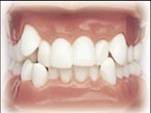
Left uncorrected crowding can:/p>
- prevent proper cleaning of all the
surfaces of your teeth
- cause dental decay
- increase the chances of gum disease
- result in excessive enamel wear
- make your smile less attractive
MMany patients seek orthodontic treatment to
align crooked and crowded teeth. The decision
that the orthodontist must make in evaluating
such a patient is whether or not he / she can
align all of the teeth without extracting /
removing any permanent teeth. The factors to
consider in making this decision are the
severity of the crowding, the bite, the
thickness and height of the gingiva (“gums”),
and whether or not these teeth are already too
pronounced (leaning outwards) in the jaws.
Certain patients are best treated with braces
and the extraction of teeth in order to correct
the alignment of the teeth, improve the bite,
improve the health of the gums and enhance the
smile.
The cause of spacing may be heredity or some
personal habit like tongue thrusting, thumb
sucking, abnormal swallowing, etc. Another cause
in adults is advanced gum disease, leading to
loss of supporting bone and the teeth spreading
out.
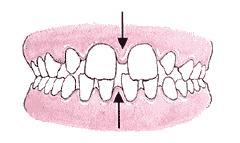
The spaces can be closed with braces and
other orthodontic appliances by moving the teeth
together and properly aligning them within the
arch.
Open bites occur when the upper front teeth
don't meet or even cover the lower front teeth.
The cause can be genetic, but more often is due
to oral habits such as thumb sucking or unusual
positioning of the tongue./p>
Open bites make proper chewing difficult as
it is impossible to bite off food. They may
cause speech impediments as well as difficulty
to close the lips leading to mouth breathing,
and drying and inflammation of the gums around
the front teeth.
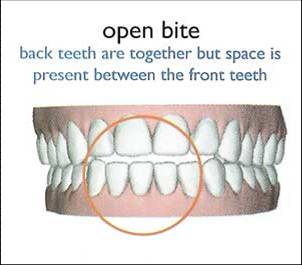
Although many treatment modalities are used
in an attempt to correct an open bite,
particularly, an anterior open bite, the success
rate of achieving correction, proper overlap of
the incisors is 80%. In other words, there are
20% of patients who do not have correction of
the open bite.
The orthodontic treatments
for open bite are used singly, or in
combination. These are: oblique headgear,
clenching exercises, vertical elastics,
posterior bite blocks, and orthognathic surgery.
TThere are many possible explanations for the
instability of open bite corrections, but the
most important is the non-adaptability of the
tongue. Most open bites are associated with a
tongue thrusting, or reverse swallowing pattern.
Therefore, even after initial removal of
orthodontic appliances, and the open bite has
been correct, the open bite may relapse, return,
due to the tongue thrusting pattern.
The center lines of upper and
lower teeth don't align.
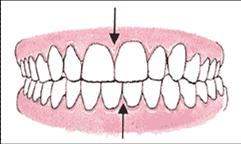
This can easily be corrected with braces or
Invisalign can be the ideal solution in many
such cases. And while Invisalign works for most
orthodontic problems, only Dr. Garemani can tell
you if this will work for you.
Please feel free to contact the office if you
are experiencing any discomfort or if you have
any questions. Below are a few simple steps that
might help if you are unable to contact us or if
you need a “quick fix”.
Loose Bracket
Occasionally, a glued bracket may come loose.
You can remove the loose bracket and save it in
an envelope to bring to the office or leave it
where it is, if it is not causing any
irritation. Call the office as soon as possible
in order for us to allow time to re-glue the
bracket.
Poking Wire
If a wire is poking your gums or cheek there
are several things you can try until you can get
to the office for an appointment. First try a
ball of wax on the wire that is causing the
irritation. You may also try using a nail
clipper or cuticle cutter to cut the extra piece
of wire that is sticking out. Sometimes, a
poking wire can be safely turned down so that it
no longer causes discomfort. To do this you may
use a pencil eraser, or some other smooth
object, and tuck the offending wire back out of
the way.
Wire out of Back Brace
Please be careful to avoid hard or sticky
foods that may bend the wire or cause it to come
out of the back brace. If this does happen, you
may use needle nose pliers or tweezers to put
the wire back into the hole in the back brace.
If you are unable to do this, you may clip the
wire to ease the discomfort. Please call the
office as soon as possible to schedule an
appointment to replace the wire.
Poking Elastic (Rubber Band) Hook
Some brackets have small hooks on them for
elastic wear. These hooks can occasionally
become irritating to the lips or cheeks. If this
happens, you may either use a pencil eraser to
carefully push the hook in, or you can place a
ball of wax on the hook to make the area feel
smooth.
Sore Teeth
You may be experiencing some discomfort after
beginning treatment or at the change of wires or
adjusting of appliances. This is normal and
should diminish within 24-72 hours. A few
suggestions to help with the discomfort:
- Rinse with warm water, eat a soft diet,
take acetaminophen (Tylenol) or ibuprofen
(Advil) as directed on the bottle.
- Chewing on the sore teeth may be sorer
in the short term but feel better faster.
- IIf pain persists more than a few days,
call our office.
Orthodontic Care
You will be shown the proper care of your
braces when your orthodontic treatment begins.
Proper cleansing of your mouth is necessary
every time you eat. Teeth with braces are harder
to clean, and trap food very easily. If food is
left lodged on the brackets and wires, it can
cause unsightly etching of the enamel on your
teeth. Your most important job is to keep your
mouth clean. If food is allowed to collect, the
symptoms of gum disease will show in your mouth.
The gums will swell and bleed and the pressure
from the disease will slow down tooth movement.
BRUSHING: You should brush
your teeth 4-5 times per day.
- Brush back and forth across……between the
wires and gums on the upper and lower to
loosen any food particles.
- Next, brush correctly as if you had no
brackets or appliances on.
- Start on the outside of the uppers with
the bristles at a 45 degree angle toward the
gum and scrub with a circular motion two or
three teeth at a time using ten strokes,
then move on.
- Next, do the same on the inner surface
of the upper teeth.
- Then, go to the lower teeth and repeat
steps 1 & 2.
Look in a mirror to see if you have missed
any places. Your teeth, brackets and wires
should be free of any food particles and plaque.
Note: If your gums bleed when
brushing, do not avoid brushing, but rather
continue stimulating the area with the bristles.
Be sure to angle your toothbrush so that the
area under your gum line is cleaned. After 3 or
4 days of proper brushing, the bleeding should
stop and your gums should be healthy again.
FLOSSING: Use a special
floss threader to floss with your braces on. Be
sure to floss at least once per day.
Appliance Care
Clean the retainer by brushing with
toothpaste. If you are wearing a lower fixed
retainer be extra careful to brush the wire and
the inside of the lower teeth. Always bring your
retainer to each appointment. Avoid flipping the
retainer with your tongue, this can cause damage
to your teeth. Place the retainer in the plastic
case when it is re-moved from your mouth. Never
wrap the retainer in a paper napkin or tissue,
someone may throw it away. Don't put it in your
pocket or you may break or lose it. Excessive
heat will warp and ruin the retainer.
Elastics Care
IIf elastics (rubber bands) are worn
intermittently, they will continually "shock"
the teeth and cause more soreness. Sore teeth
between appointments usually indicate improper
wear of headgear or elastics or inadequate
hygiene. Wear your elastics correctly, attaching
them as you were told. Wear elastics all the
time, unless otherwise directed. Take your
elastics off while brushing. Change elastics as
directed, usually once or twice a day.
Avoid Sticky Foodsbr> such as:
Caramels
Skittles
Candy
bars with caramel
Starbursts
Fruit Roll-Ups
Toffee
Gum
Gummy
Bears
Candy or caramel apples |
Avoid Hard or Tough
Foods such
as:
Pizza Crust
Ice cubes
Nuts
Bagels
Hard Candy
Popcorn
Kernels
Corn Chips |
Cut the following
foods into small pieces and chew with
the back teeth:
Apple
Pears
Carrots
Celery
Corn on
the Cob
Chicken wings
Pizza
SSpare Ribs |
|
Aligners — an
alternative to traditional braces for
adults, serial aligners are being used
by an increasing number of orthodontists
to move teeth in the same way that fixed
appliances work, only without metal
wires and brackets. Aligners are
virtually invisible and are removed for
eating, brushing and flossing.
|
 |
|
Removable space maintainers
— these devices serve the same function
as fixed space maintainers. They're made
with an acrylic base that fits over the
jaw, and have plastic or wire branches
between specific teeth to keep the space
between them open.
|
 |
|
Jaw repositioning appliances
— also called splints, these devices are
worn on either the top or lower jaw, and
help train the jaw to close in a more
favorable position. They may be used for
temporomandibular
joint disorders
(TMJ).
|
 |
|
Lip and cheek bumpers
— these are designed to keep
the lips or cheeks away from the teeth.
Lip and cheek muscles can exert pressure
on the teeth, and these bumpers help
relieve that pressure.
|
 |
|
Palatal expander — a
device used to widen the arch of the
upper jaw. It is a plastic plate that
fits over the roof of the mouth. Outward
pressure applied to the plate by screws
force the joints in the bones of the
palate to open lengthwise, widening the
palatal area.
|
 |
|
Removable retainers
— worn on the roof of the mouth, these
devices prevent shifting of the teeth to
their previous position. They can also
be modified and used to prevent thumb
sucking.
|
 |
Retainers are custom-made devices, made
usually of wires or clear plastic, that hold
teeth in position after surgery or any method of
realigning teeth. They are most often used
before or after dental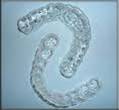 braces to hold teeth in position while assisting
the adjustment of the surrounding gums to
changes in the bone. Most patients are required
to wear their retainers every night at first,
with many also being directed to wear them
during the day - at least initially. They should
not be worn while eating food or drinking
staining or acidic beverages (e.g., Cola
products and coffee).
braces to hold teeth in position while assisting
the adjustment of the surrounding gums to
changes in the bone. Most patients are required
to wear their retainers every night at first,
with many also being directed to wear them
during the day - at least initially. They should
not be worn while eating food or drinking
staining or acidic beverages (e.g., Cola
products and coffee).
When your braces come off it Is very tempting
not to wear your retainers. To keep your teeth
from shifting and avoiding having to wear braces
again, it is crucial to wear your retainers as
often as your orthodontist tells you.
Back to the Top
|
